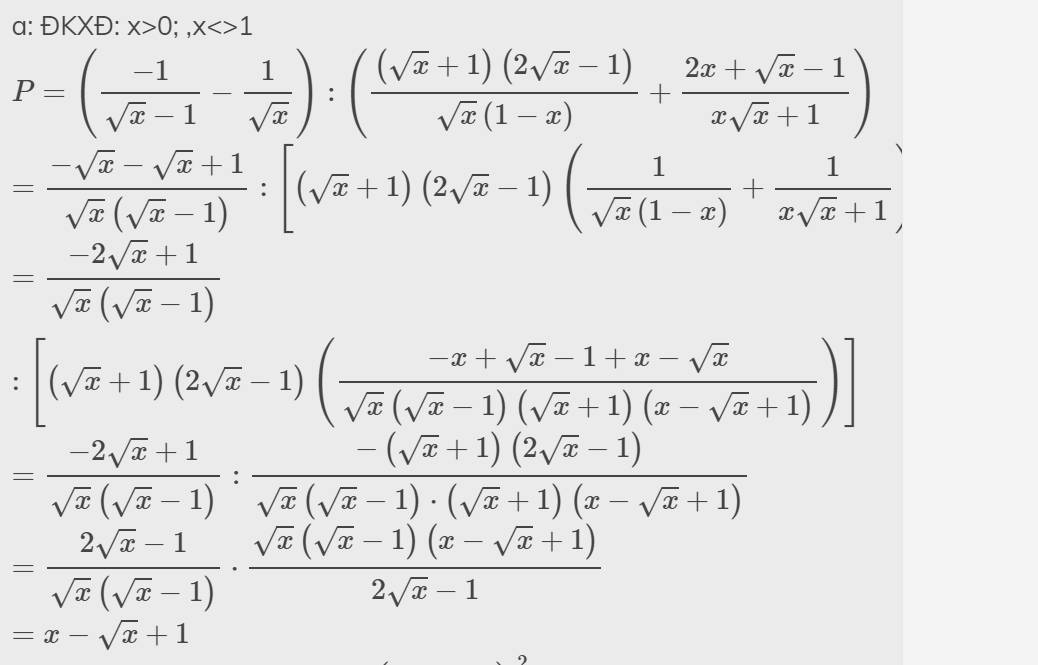Cho P = \(\dfrac{1}{\sqrt{x}-1}\); Q = \(\dfrac{1}{\sqrt{x}+1}\)(ĐKXĐ: x ≥ 0; x ≠ 1). Tìm x thỏa mãn: \(\dfrac{1}{Q}+P\le4\)
Hãy nhập câu hỏi của bạn vào đây, nếu là tài khoản VIP, bạn sẽ được ưu tiên trả lời.


\(P=\left(\dfrac{x-2+\sqrt{x}}{\left(\sqrt{x}+2\right)\left(\sqrt{x}\right)}\right)\cdot\dfrac{\sqrt{x}+1}{\sqrt{x}-1}\)
\(=\dfrac{\left(\sqrt{x}+2\right)\left(\sqrt{x}-1\right)}{\left(\sqrt{x}+2\right)\left(\sqrt{x}-1\right)}\cdot\dfrac{\sqrt{x}+1}{\sqrt{x}}=\dfrac{\sqrt{x}+1}{\sqrt{x}}\)

Điều kiện: x>2
P= \(\left(\dfrac{1}{\sqrt{x}-1}-\dfrac{1}{\sqrt{x}}\right):\left(\dfrac{\sqrt{x}+1}{\sqrt{x}-2}-\dfrac{\sqrt{2}+2}{\sqrt{x}-1}\right)\)
P= \(\left(\dfrac{\sqrt{x}-\sqrt{x}+1}{\sqrt{x}\left(\sqrt{x}-1\right)}\right):\left(\dfrac{x-1-x+4}{\left(\sqrt{x}-2\right)\left(\sqrt{x}-1\right)}\right)\)
P= \(\dfrac{1}{\sqrt{x}\left(\sqrt{x}-1\right)}.\dfrac{\left(\sqrt{x}-2\right)\left(\sqrt{x}-1\right)}{3}\)
P= \(\dfrac{\sqrt{x}-2}{3\sqrt{x}}\)
b) P= \(\dfrac{1}{4}\)
⇔\(\dfrac{\sqrt{x}-2}{3\sqrt{x}}\) =\(\dfrac{1}{4}\)
⇔\(4\sqrt{x}-8=3\sqrt{x}\)
⇔\(\sqrt{x}=8\)
⇔x=64 (TM)
Vậy X=64(TMĐK) thì P=\(\dfrac{1}{4}\)

\(a,P\) xác định \(\Leftrightarrow\left[{}\begin{matrix}x>0\\x\ne1\\x\ne4\end{matrix}\right.\)
\(b,P=\left(\dfrac{1}{\sqrt{x}-1}-\dfrac{1}{\sqrt{x}}\right):\left(\dfrac{\sqrt{x}+1}{\sqrt{x}-2}-\dfrac{\sqrt{x}+2}{\sqrt{x}-1}\right)\\ =\dfrac{\sqrt{x}-\sqrt{x}+1}{\sqrt{x}\left(\sqrt{x}-1\right)}:\dfrac{\left(\sqrt{x}+1\right)\left(\sqrt{x}-1\right)-\left(\sqrt{x}+2\right)\left(\sqrt{x}-2\right)}{\left(\sqrt{x}-2\right)\left(\sqrt{x}-1\right)}\\ =\dfrac{1}{\sqrt{x}\left(\sqrt{x}-1\right)}.\dfrac{\left(\sqrt{x}-2\right)\left(\sqrt{x}-1\right)}{x-1-x+4}\\ =\dfrac{1}{\sqrt{x}}.\dfrac{\sqrt{x}-2}{3}\\ =\dfrac{\sqrt{x}-2}{3\sqrt{x}}\)
\(c,P=\dfrac{1}{4}\Leftrightarrow\dfrac{\sqrt{x}-2}{3\sqrt{x}}=\dfrac{1}{4}\\ \Leftrightarrow\dfrac{4\left(\sqrt{x}-2\right)-3\sqrt{x}}{12\sqrt{x}}=0\\ \Leftrightarrow4\sqrt{x}-8-3\sqrt{x}=0\\ \Leftrightarrow\sqrt{x}=8\\ \Leftrightarrow x=64\left(tmdk\right)\)
Vậy \(x=64\) thì \(P=\dfrac{1}{4}\)

c: P nguyên
=>căn x+1+4 chia hết cho căn x+1
=>căn x+1 thuộc {1;2;4}
=>x thuộc {1;9}

Áp dụng BĐT Cauchy-Schwarz ta có:
\(\dfrac{1}{\sqrt{x}+2\sqrt{y}}\le\dfrac{1}{9}\left(\dfrac{1}{\sqrt{x}}+\dfrac{1}{\sqrt{y}}+\dfrac{1}{\sqrt{y}}\right)\)
Tương tự cho 2 BĐT trên ta có:
\(\dfrac{1}{3}VP\le\dfrac{1}{9}\cdot3\left(\dfrac{1}{\sqrt{x}}+\dfrac{1}{\sqrt{y}}+\dfrac{1}{\sqrt{z}}\right)\)
\(=\dfrac{1}{3}\left(\dfrac{1}{\sqrt{x}}+\dfrac{1}{\sqrt{y}}+\dfrac{1}{\sqrt{z}}\right)=\dfrac{1}{3}VT\)
Xảy ra khi \(x=y=z\)

a) Tìm điều kiện xác định
b) Rút gọn biểu thức
c) CMR: A>0 với mọi x \(\ne\)1
d) Tìm x để A đạt GTLN,tìm x để A đạt GTLN đó



hình như đề là tìm x thỏa mãn: \(\dfrac{1}{Q}+P\ge4\) thì phải
nếu vậy thì ta có \(\dfrac{1}{Q}+P\) = \(\sqrt{x}+1+\dfrac{1}{\sqrt{x}-1}\)
= \(\sqrt{x}-1+\dfrac{1}{\sqrt{x}-1}+2\)
≥ 2+2 = 4(bđt Cauchy)
vậy \(\dfrac{1}{Q}+P\ge4\)